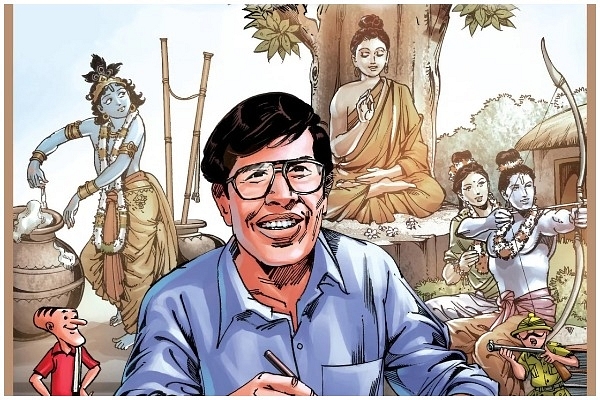Culture
Uncle Pai Brought India’s Stories To Indians, And Academia Heaped Scorn On Him
- Anant Pai accomplished the herculean task of collecting stories from across India and spreading them across the country.
- And India’s left-dominated academia did what it does best — declare him to be a reactionary, Brahminical Hindu.

Uncle Pai
Today, 17 September, is the birth anniversary of Anant Pai, the creator and the first writer, editor and publisher for Amar Chitra Katha. For around three generations of Indians now, Amar Chitra Katha has been their first storyteller, and in most cases, their favourite one.
The comics not only connected Indians across time to heroes and epics of the past, but also across geographical distances. In the collection of its titles, the Amar Chitra Katha series put together stories from all regions of India and distributed them to all.
Using comics as his medium, Anant Pai, known as Uncle Pai to readers, brought mythology, bravehearts, epics, folktales, literary masterpieces, biographies of visionaries from every region of India to our children.
Consider some of the themes and personalities he covered in his comics: Bagha Jatin of Bengal who fought the British knowing very well how the battle would end; Yellapragada Subbarao, the scientist from Andhra Pradesh, who discovered wonder drugs to alleviate pain and suffering; Sri Narayana Guru of Kerala heralding a socio-spiritual revolution, the myth of Jagannath of Puri which harmonises the tribal and non-tribal elements, the different local versions about the sons of Pandavas, the supreme sacrifices of the Sikh gurus, heart-rendering story of Angulimala – the mass-murderer turned saint, who calmly accepted his own stoning to death!
Amar Chitra Katha is essentially a unique Indian phenomenon of child literature. It is both an experiment and an achievement. It is one of the few things an Indian can be legitimately proud of in modern India.
One wonders if there has been any other comic house in the world that has achieved such variety in content and more importantly such meticulous research in the issues it brought out.
The Scorn Of The Academia
So, how did the left academia react to Uncle Pai?
They were quick to hurl abuses and branded Amar Chitra Katha as a series portraying ‘Brahminical’ values, presenting only the ‘dominant narrative’, etc. Almost all ‘academic’ analysis of Amar Chitra Katha is negative in tone. Here is a typical academic ‘perspective’ from a Hyderabad University researcher:
How factually hollow and vicious in its content this attack is, can be gauged if we bring together the different issues of Amar Chitra Katha.
In the case of ‘Dayananda’ (Volume 624), there is not ‘one panel allotted to showing Brahminical oppression of ‘lower’ castes but three (page 13), and the plight of the poor is shown in the next page in three panels.
At page 20, in which it has been alleged that the ‘assimilation of these castes into mainstream Hinduism’ gets four panels, we also find three panels depicting the Hindu orthodoxy’s violent opposition to Dayananda’s social reform measures.
Prior to Dayananda, ‘Baba Saheb Ambedkar’ (Volume 611) had been published by Amar Chitra Katha. Here, Dr Ambedkar has been shown as both the nation-builder as well as the champion of the rights of the oppressed. Amar Chitra Katha does not mince words when depicting Dr Ambedkar’s sharp attacks on Smriti-based Hinduism.
Similarly, the Amar Chitra Katha issue on Basaveshwara (1980) also depicts the tyranny of the upper classes on the Dalit communities in various panels. Once again, the title ‘Narayana Guru’ (Volume 792) has its first four pages with 21 panels depicting the notorious ‘lunatic asylum’ condition of Kerala under the stagnant casteist oppression.
Even more bizarre and blatant falsehoods are stated by leftist academics. These are then re-quoted without verification – just to portray Amar Chitra Katha negatively. The same scholar states:
One just has to look at the covers of Amar Chitra Katha of the issues Kannagi (Volume 666) and Padmini (Volume 605) to know the utter falsehood of this statement. The Nehruvian establishment and its evolutes have not only been produced and profited by cultural illiteracy in India but also venomously attack any attempt to remove such cultural illiteracy.
But thankfully for us a market-oriented, uniquely Indic attempt by Uncle Pai has made it easy for Indian children to understand India’s greatness.
Taking Indian history to every child needs further dedication. Translation into regional languages, subsidising the cost for accessibility to all economic strata (in 1980s one issue was Rs 3 and today it is Rs 50) are just some of the gigantic tasks awaiting the new Bhagirathas, who want to take this Ganga of Indic heritage to the next generation.
Picture Credits for Hero Image: Amar Chitra Katha’s Twitter Handle
An earlier version of this piece was published as ‘Remembering Uncle Pai’ on 24 February 2016.
Support Swarajya's 50 Ground Reports Project & Sponsor A Story
Every general election Swarajya does a 50 ground reports project.
Aimed only at serious readers and those who appreciate the nuances of political undercurrents, the project provides a sense of India's electoral landscape. As you know, these reports are produced after considerable investment of travel, time and effort on the ground.
This time too we've kicked off the project in style and have covered over 30 constituencies already. If you're someone who appreciates such work and have enjoyed our coverage please consider sponsoring a ground report for just Rs 2999 to Rs 19,999 - it goes a long way in helping us produce more quality reportage.
You can also back this project by becoming a subscriber for as little as Rs 999 - so do click on this links and choose a plan that suits you and back us.
Click below to contribute.
Latest